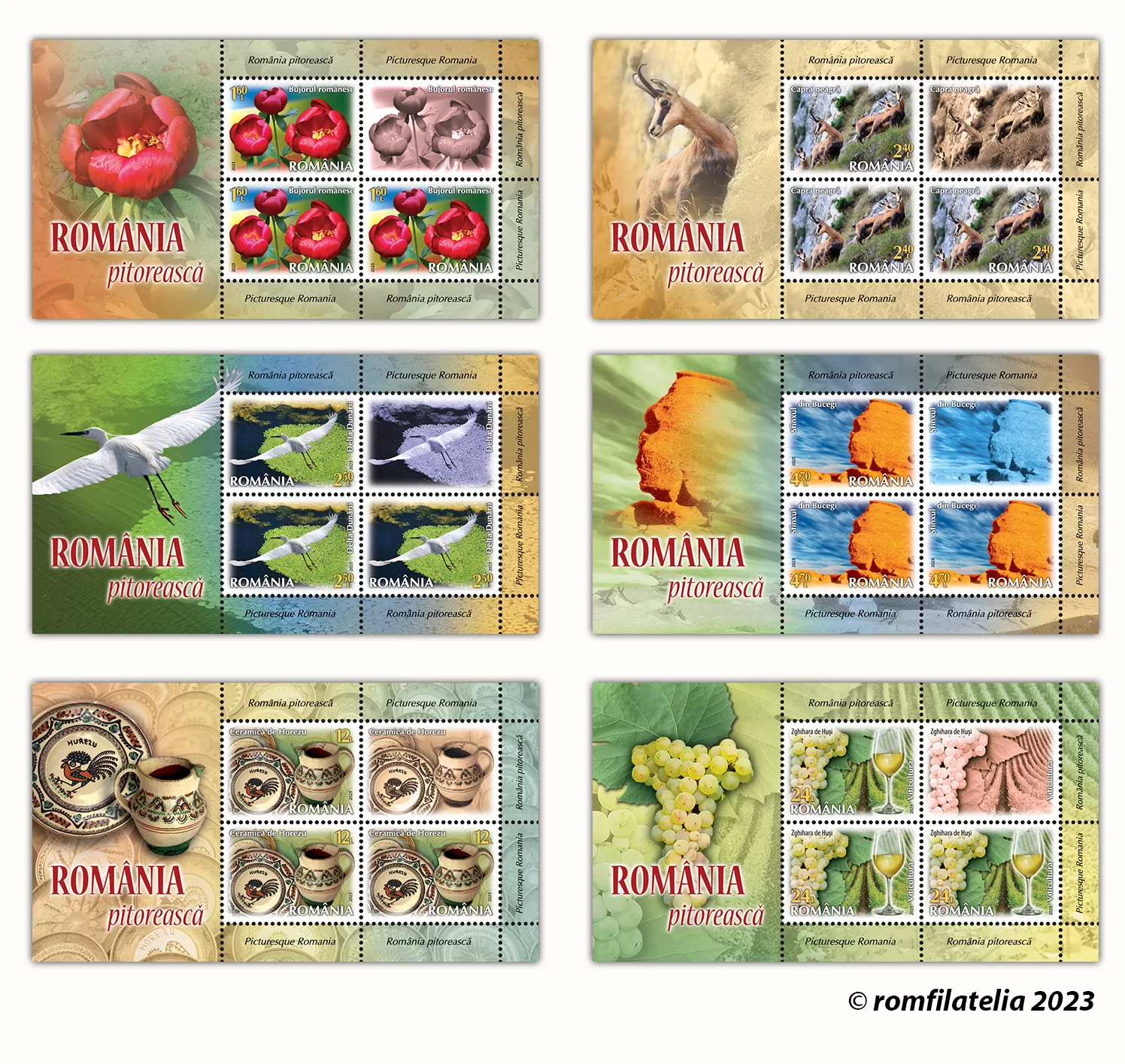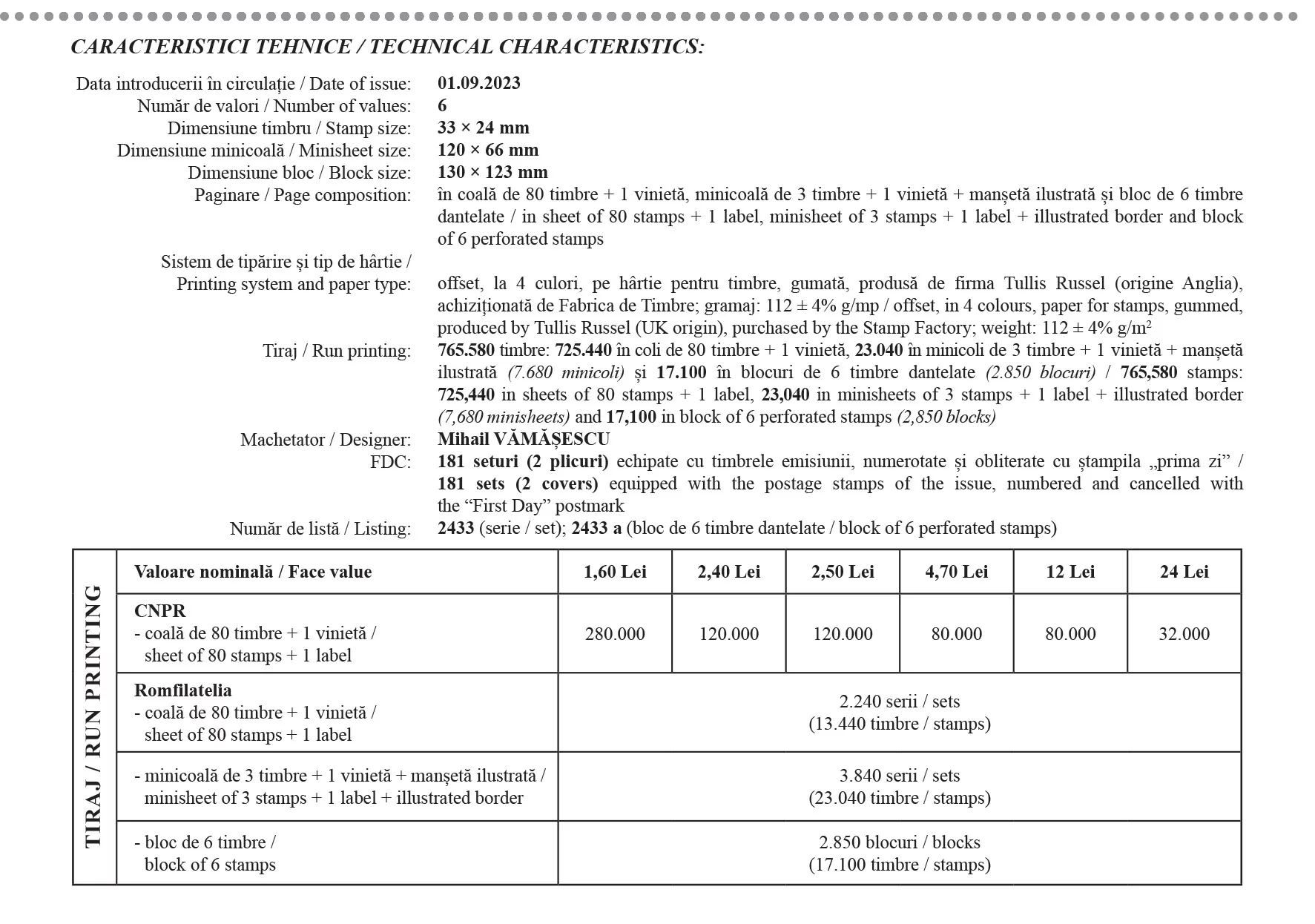 One of the most beautiful countries in Europe, Romania offers countless travel experiences that are waiting to be experienced and discovered, and the words that best describe the essence of Romania’s specificity are: authentic, natural and cultural.
One of the most beautiful countries in Europe, Romania offers countless travel experiences that are waiting to be experienced and discovered, and the words that best describe the essence of Romania’s specificity are: authentic, natural and cultural.
Romfilatelia, guided by the motto “a world in a stamp”, introduces into circulation on Friday, September 1, this year, the issue of definitive postage stamps Picturesque Romania, inviting philately lovers to take an imaginary trip through our country. In this issue we present a small part of the country’s natural treasures and we are waiting for you to be our guests.
Within the issue, consisting of 6 postage stamps, 1 block of 6 perforated stamps and 2 First Day Covers, you will discover: the Romanian peony (face value of Lei 1.60), the chamois (face value of Lei 2.40), a landscape of the Danube Delta (face value of Lei 2.50), the Sphinx of Bucegi (face value of Lei 4.70), Horezu pottery (face value of Lei 12) and viticulture (face value of Lei 24).
The peony is the floral emblem of Romania, which officially became, by the Law no. 285 of October 26, 2022, adopted by the Romanian Parliament, the national flower of Romania by.
The chamois (Rupicapra rupicapra) is protected by law in our country and is one of the most valuable species belonging to the fauna of Romania. It is considered the true pearl of the mountains, found on their crests.
Danube Delta. Europe’s youngest land entered the UNESCO World Heritage in 1991 as a Biosphere Reserve. Among hundreds of other birds, the Little Egret (Egretta garzetta), a species half the size of the Big Egret with faster wingbeats, makes its home here.
The Bucegi area, considered a special energy centre of the spirits of the Dacian deities, has made the Sphinx, this monument of nature, a symbol of the country inhabited by the ancestors of the Geto-Dacians. It is treated as a symbol of eternal and living faith, of the preservation of ancestral territory.
The technique of Horezu pottery is a unique traditional craft, practiced by both men and women in the northern part of Vâlcea county. The colours are vivid and vary from dark brown, red, green and blue to the famous ivory of Horezu, and the symbols represented are the fish, the snake, the rooster, the tree of life, the oak leaf.
The decision to include the technique of traditional Horezu pottery on the UNESCO Representative List of Intangible Cultural Heritage is a recognition of hundreds of years of unaltered tradition.
On the current territory of Romania, viticulture was an occupation whose oldness is lost in the mists of time.
“The old homeland of the Geto – Dacians, Tracia – wrote the Romanian historian A.D. Xenopol – was a viticultural region, reason for which it was considered as the birth place of the God of Wine, Dionysos.”
Numerous archaeological discoveries attest the cultivation of vines on the Romanian territory since the Neolithic, and the words strugure (grape) and butuc (snag) have remained from the Dacians.
Zghihara of Huși, also known as Poamă zoșănească (in free translation, Husi Zonal Fruit), Zghihară galbenă (in free translation, Yellow Zghihara), Ghihară, Zghihară verde bătută (in free translation, Washout Green Zghihara), Yellow of Huși, Poamă vinoasă, Zghihara of Huși is a highly productive variety, with origins in the vineyards of Huși, being cultivated since ancient times, perhaps 5-6 centuries ago, on the banks of the Prut, even before the city from which it takes its name. In his “Descriptio Moldaviae”, Dimitrie Cantemir placed the wine of Huși, from the lands of Fălciului, the second best after Cotnari.
Romfilatelia thanks the photographers Ioana Chiriță, George Avanu, Octavian Chende and Șerban Sîmbotelecan, for the collaboration within this issue of postage stamps.



